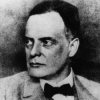Paul Klee

Paul Klee
Paul Kleewas a Swiss-German artist. His highly individual style was influenced by movements in art that included Expressionism, Cubism, and Surrealism. Klee was a natural draftsman who experimented with and eventually deeply explored color theory, writing about it extensively; his lectures Writings on Form and Design Theory, published in English as the Paul Klee Notebooks, are held to be as important for modern art as Leonardo da Vinci's A Treatise on Painting for the Renaissance. He and his colleague, Russian...
NationalitySwiss
ProfessionPainter
Date of Birth18 December 1879
CityMunchenbuchsee, Switzerland
CountrySwitzerland
A tendency toward the abstract is inherent in linear expression: graphic imagery being confined to outlines has a fairy-like quality and at the same time can achieve great precision.
It is possible that a picture will move far away from Nature and yet find its way back to reality. The faculty of memory, experience at a distance produces pictorial associations.
It is interesting to observe how real the object remains, in spite of all abstractions.
The pictorial work was born of movement, is itself recorded movement, and is assimilated through movement (eye muscles).
A line comes into being. It goes out for a walk, so to speak, aimlessly for the sake of the walk.
Colour has taken hold of me; no longer do I have to chase after it. I know that it has hold of me forever. That is the significance of this blessed moment
From the root, the sap rises up into the artist, flows through him, flows to his eye. Overwhelmed and activated by the force of the current, he conveys his vision into his work. And yet, standing at his appointed place as the trunk of the tree, he does nothing other than gather and pass on what rises from the depths. He neither serves nor commands he transmits. His position is humble. And the beauty at the crown is not his own; it has merely passed through him.
Nothing can be rushed. It must grow, it should grow of itself, and if the time ever comes for that work, then so much the better!
There is plenty of room left for exact experiment in art, and the gate has been opened for some time. What had been accomplished in music by the end of the eighteenth century has only begun in the fine arts. Mathematics and physics have given us a clue in the form of rules to be strictly observed or departed from, as the case may be. Here salutary discipline is come to grips first of all with the function of forms, and not with form as the final result … in this way we learn how to look beyond the surface and get to the root of things.
See with one eye, feel with the other.
Polyphonic painting is superior to music in that there, the time element becomes a spatial element. The notion of simultaneity stands out even more richly.
All the things an artist must be: poet, explorer of nature, philosopher!
The beautiful, which is perhaps inseparable from art, is not after all tied to the subject, but to the pictorial representation. In this way and in no other does art overcome the ugly without avoiding it.
To achieve vital harmony in a picture it must be constructed out of parts in themselves incomplete, brought into harmony only at the last stroke.